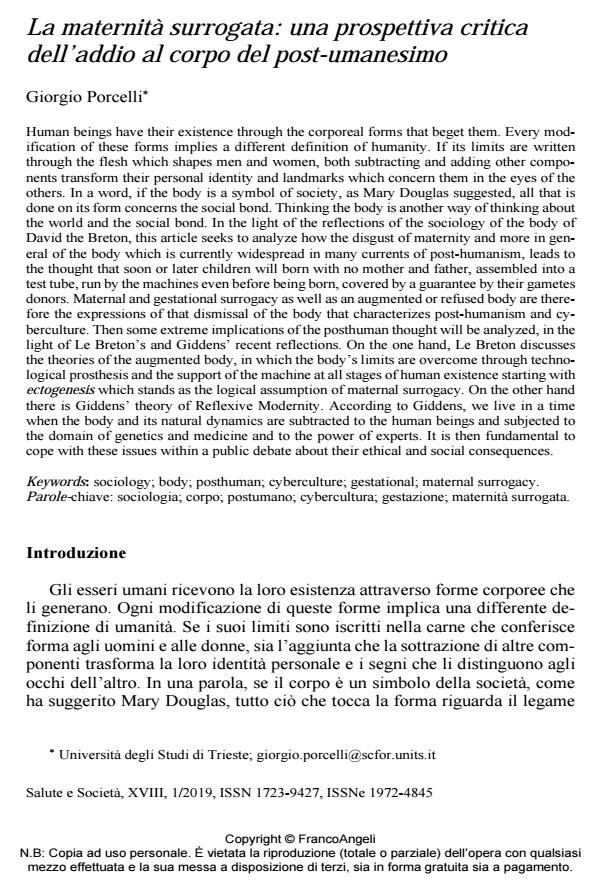La maternità surrogata: una prospettiva critica dell’addio al corpo del post-umanesimo
Titolo Rivista SALUTE E SOCIETÀ
Autori/Curatori Giorgio Porcelli
Anno di pubblicazione 2019 Fascicolo 2019/1
Lingua Italiano Numero pagine 22 P. 60-81 Dimensione file 228 KB
DOI 10.3280/SES2019-001005
Il DOI è il codice a barre della proprietà intellettuale: per saperne di più
clicca qui
Qui sotto puoi vedere in anteprima la prima pagina di questo articolo.
Se questo articolo ti interessa, lo puoi acquistare (e scaricare in formato pdf) seguendo le facili indicazioni per acquistare il download credit. Acquista Download Credits per scaricare questo Articolo in formato PDF

FrancoAngeli è membro della Publishers International Linking Association, Inc (PILA)associazione indipendente e non profit per facilitare (attraverso i servizi tecnologici implementati da CrossRef.org) l’accesso degli studiosi ai contenuti digitali nelle pubblicazioni professionali e scientifiche
Human beings have their existence through the corporeal forms that beget them. Every modification of these forms implies a different definition of humanity. If its limits are written through the flesh which shapes men and women, both subtracting and adding other components transform their personal identity and landmarks which concern them in the eyes of the others. In a word, if the body is a symbol of society, as Mary Douglas suggested, all that is done on its form concerns the social bond. Thinking the body is another way of thinking about the world and the social bond. In the light of the reflections of the sociology of the body of David the Breton, this article seeks to analyze how the disgust of maternity and more in general of the body which is currently widespread in many currents of post-humanism, leads to the thought that soon or later children will born with no mother and father, assembled into a test tube, run by the machines even before being born, covered by a guarantee by their gametes donors. Maternal and gestational surrogacy as well as an augmented or refused body are therefore the expressions of that dismissal of the body that characterizes post-humanism and cyberculture. Then some extreme implications of the posthuman thought will be analyzed, in the light of Le Breton’s and Giddens’ recent reflections. On the one hand, Le Breton discusses the theories of the augmented body, in which the body’s limits are overcome through technological prosthesis and the support of the machine at all stages of human existence starting with ectogenesis which stands as the logical assumption of maternal surrogacy. On the other hand there is Giddens’ theory of Reflexive Modernity. According to Giddens, we live in a time when the body and its natural dynamics are subtracted to the human beings and subjected to the domain of genetics and medicine and to the power of experts. It is then fundamental to cope with these issues within a public debate about their ethical and social consequences.
Parole chiave:Sociologia; corpo; postumano; cybercultura; gestazione; maternità surrogata.
- Mother Nature and the nature of motherhood: Gestational surrogacy and ecospirituality as two postmodern forms of sacralization Antonio Camorrino, in Current Sociology /2021 pp.212
DOI: 10.1177/0011392120964894
Giorgio Porcelli, La maternità surrogata: una prospettiva critica dell’addio al corpo del post-umanesimo in "SALUTE E SOCIETÀ" 1/2019, pp 60-81, DOI: 10.3280/SES2019-001005